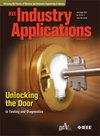A High Precision Observer Using a Full-Range Harmonics Suppression Scheme for High-Speed Permanent Magnet Synchronous Motor
IF 4.5
2区 工程技术
Q2 ENGINEERING, ELECTRICAL & ELECTRONIC
引用次数: 0
Abstract
The sensorless control of permanent magnet synchronous motors (PMSMs) using a sliding mode observer (SMO) to extract the back electromotive force(BEMF) is susceptible to various disturbances such as modulation algorithms, inverter switching characteristics, and current sampling errors. These factors contribute to the presence of significant low and high frequency harmonics component in the stator current, which in turn deteriorates the accuracy of the speed and position estimation. These harmonics not only affect the performance of the SMO but also hinder the overall control system’s dynamic response. To address these challenges, this paper presents a high-precision harmonics suppression scheme based on a full-frequency domain approach. The proposed solution involves a series of adaptive comb filters (SACF) to effectively suppress low-frequency harmonics, thereby eliminating phase delays and improving BEMF estimation. Additionally, an LC filter combined with a frequency adaptive notch filter (FANF) is employed to mitigate high-frequency harmonics, which are particularly problematic due to their interaction with the sampling process. Experimental results validate the practicality and effectiveness of this proposed strategy. The proposed method significantly reduces harmonic components in the motor, leading to notable improvements in the dynamic performance of the control system and enhanced accuracy of speed and position estimation.高速永磁同步电机全范围谐波抑制方案的高精度观测器
利用滑模观测器(SMO)提取反电动势(BEMF)的永磁同步电动机无传感器控制容易受到调制算法、逆变器开关特性和电流采样误差等各种干扰。这些因素导致定子电流中存在显著的低频和高频谐波成分,从而降低了速度和位置估计的准确性。这些谐波不仅影响SMO的性能,而且影响整个控制系统的动态响应。为了解决这些问题,本文提出了一种基于全频域方法的高精度谐波抑制方案。该解决方案采用一系列自适应梳状滤波器(SACF)来有效抑制低频谐波,从而消除相位延迟并改善BEMF估计。此外,LC滤波器与频率自适应陷波滤波器(FANF)相结合,用于减轻高频谐波,由于它们与采样过程的相互作用,高频谐波特别成问题。实验结果验证了该策略的实用性和有效性。该方法显著降低了电机中的谐波分量,显著改善了控制系统的动态性能,提高了速度和位置估计的精度。
本文章由计算机程序翻译,如有差异,请以英文原文为准。
求助全文
约1分钟内获得全文
求助全文
来源期刊

IEEE Transactions on Industry Applications
工程技术-工程:电子与电气
CiteScore
9.90
自引率
9.10%
发文量
747
审稿时长
3.3 months
期刊介绍:
The scope of the IEEE Transactions on Industry Applications includes all scope items of the IEEE Industry Applications Society, that is, the advancement of the theory and practice of electrical and electronic engineering in the development, design, manufacture, and application of electrical systems, apparatus, devices, and controls to the processes and equipment of industry and commerce; the promotion of safe, reliable, and economic installations; industry leadership in energy conservation and environmental, health, and safety issues; the creation of voluntary engineering standards and recommended practices; and the professional development of its membership.
 求助内容:
求助内容: 应助结果提醒方式:
应助结果提醒方式:


